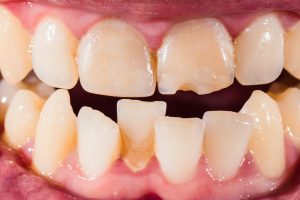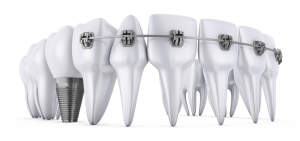Am I too old for braces or clear aligners?
Most people associate orthodontic treatment with teenagers and younger folks. The sooner you start your orthodontic treatment, the easier it is to correct your condition. Orthodontists recommend that you get evaluated for your teeth relationship by age 6 or 7. Early assessment allows for interceptive orthodontic treatment, also referred to as phase one. It’s easier to move teeth when you’re younger because your bones are still soft and they haven’t fused yet. However, not everyone is fortunate enough to have orthodontic treatment in their youth. Do adults qualify for orthodontic treatment? How about seniors? And when exactly are you too old for braces and clear aligners? Let’s find out:

What is the best age to start orthodontic treatment?
The ideal age to start orthodontic treatment is your teen years. typically between the ages of 11 to 16. Orthodontists recommend that you start comprehensive orthodontic treatment, also referred to as phase two, once all of your adult teeth have erupted. This usually occurs at around age 11 for girls and 12 for boys. The goal is to finish your orthodontic treatment by age 17. By this time your facial bones finish fusing which makes it more difficult to move teeth.
When are you too old for orthodontic treatment?

You’re never too old to straighten your smile and improve your smile. Age is not a limiting factor when it comes to receiving orthodontic treatment. You can get braces or clear aligners no matter how old you are. As long as your teeth and gums are healthy enough to support braces or aligners, you can receive orthodontic treatment. Whether you’re in your forties, fifties, or sixties, you may still qualify. In fact, there are several benefits to receiving orthodontic treatment as an adult, for example:
- Adults are better at keeping their appointments as compared to teenagers. This makes it easier to complete their orthodontic treatment on time.
- Adults are better at following their dentist or orthodontist’s instruction, again, yielding better end results.
- Finally, adults are better at maintaining their oral hygiene throughout their orthodontic program. As a result, they end up with fewer complications during their orthodontic program.
What are the benefits of orthodontic treatment for adults?

Straightening your teeth does more than give you a prettier smile. Here are some of the most common benefits of orthodontic treatment for adults:
Improve your appearance and confidence
There’s no question that having a straight smile improves your appearance. After all, your smile is the first thing that others notice about you. Straightening your teeth also increases your self-confidence so you feel better about yourself and your appearance.
Reduce your risk of cavities
Patients with crooked teeth are far more likely to develop cavities, especially in-between their teeth. It’s more difficult to maintain proper oral hygiene when your teeth are crooked or when there are gaps between your teeth. Straightening your smile helps reduce your chances of developing cavities, regardless of how old you are.
Improve your gum health
Having crooked or gap teeth also makes it more difficult to maintain healthy gums. Crooked teeth gather more plaque as compared to straight teeth. If you can’t clean your teeth because of how your teeth are positioned, you eventually develop gum disease. Straightening your teeth makes it much easier to maintain healthier gums. Straightening your teeth can improve your gum health and reduce, or even eliminates, your gum disease.
Correct your bite relationship
When your teeth don’t touch the way they’re supposed to, you suffer from a poor bite relationship. Having a poor bite places additional stress onto your teeth. This causes your teeth and dental restorations, such as fillings and crowns, to chip and break more frequently. It can also lead to migraine headaches, tension pain, and other head and neck-related pain and discomfort. Improving your bite relationship using braces or clear aligners can improve your bite relationship and reduce these undesirable complications.
Is it better to wear braces or clear aligners as an adult?

Most adults prefer clear aligners over braces when given the choice. Your dentist or orthodontist will discuss clear aligners and braces with you and help you decide between the two. Keep in mind, the most difficult orthodontic cases require braces. They can not be treated with clear aligner programs like Invisalign® or Smile Direct Club™. Here are some benefits of clear aligners over braces:
- Clear aligners are more comfortable than braces
- You can remove your clear aligners to eat or clean your teeth, in contrast, braces are permanently stuck to your teeth and they can not be removed
- Clear aligners are barely visible inside your mouth making them much less noticeable than braces
- The plastic that clear aligners are made from is less likely to cut or bruise your mouth whereas wires and brackets frequently cause bruising of the mouth
- There’s no metal in clear aligners which makes it a better option for people with metal allergies or those seeking more holistic dental care
How long does adult orthodontic treatment take?
Adult orthodontic treatment takes a bit longer than treatment for teenagers. This is primarily due to the stiffening of your jawbones which makes it more difficult to move your teeth around. Simpler cases, and those of you who already had braces before, usually require 6 to 18 months of Inivisalign® or braces treatment. More complicated cases usually take 2 years or longer. Schedule a consultation with your local dentist or orthodontist to have your teeth evaluated and determine exactly how long your treatment is going to take.
How do I know if I qualify for orthodontic treatment as an adult?

People with healthy teeth and gums are usually good candidates for orthodontic treatment. They can start their orthodontic treatment as soon as they are cleared by their dentist. However, those of us who have had their fair share of dental work in the past, have a few things to consider before starting orthodontic treatment. Here are a few things you should be aware of before starting your clear aligner or braces program:
You must have healthy gums
Having healthy gums is a prerequisite to starting orthodontic treatment as an adult. If you don’t have gum disease, then a thorough dental cleaning is all you need to start your clear aligner or braces program. If you’re suffering from gum disease, you must postpone all orthodontic treatments until your gum disease is under control. Finally, those who suffer from advanced stages of gum disease don’t qualify for orthodontic treatment. It’s simply too dangerous to move your teeth if you already have extensive bone loss as a result of advanced gum disease.
Your teeth need to support braces or clear aligners
There are a few dental conditions that impact your orthodontic treatment. For example, if you have porcelain veneers on your front teeth, there’s a chance you may have to redo your veneers after completing your orthodontic treatment. If you have dental implants then you need to discuss them with your treating dentist or orthodontist. They need to make sure that they avoid putting any forces on your dental implants of they will damage them. The same goes for most fillings, crowns, and bridges. These can all have an impact on your orthodontic treatment. Your dentist or orthodontist will evaluate your mouth before starting your orthodontic program.
You should have a plan to fix the rest of your mouth
As we age we continue to develop more dental problems. Cavities, failing dental restorations, and missing teeth can complicate your orthodontic treatment. Therefore it’s important to have a long-term plan to fix these dental conditions. Be sure not to forget about fixing the rest of your mouth. Otherwise, your bite may collapse and you’ll be back to where you started within a few years.
You should have a long-term retention plan
Surely, you don’t want to redo your orthodontic treatment anytime soon! This is why you need to have a plan to keep your teeth in position after straightening them. Wear your orthodontic retainers to keep your teeth in their correct position. Consider placing a fixed retainer on your teeth if you’re the type that forgets to wear his or her retainers. Talk to your dentist or orthodontist to come up with a plan to maintain your straight smile and be sure to follow their instructions carefully.
What if I already had orthodontic treatment and need a simple touch-up?
There is good news for those of you who are considering redoing their orthodontic treatment: it’s easier to move your teeth if you’ve already had braces or clear aligners in the past. If this is your second-time receiving orthodontics, you’re very likely to qualify for clear aligner therapy. Additionally, your treatment time is expected to be much shorter. Most orthodontic relapse cases can be treated within just a few months instead of a couple of years.
How do I get started?
The first step to fixing your smile is to find a dentist or orthodontic near you. You can use our dentist Search Engine to locate a great dentist near you. View your dentist’s profile to learn more about them. View their treatment photos, list of services, reviews, and book your appointment online. Oh, and by the way, good luck with your braces/clear aligners!
0 Comments